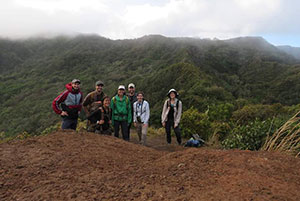Two UW Researchers Receive SERDP Grant to Study Impacts on Hawaii’s Ecosystem
Published November 08, 2023

Two University of Wyoming researchers recently received a four-year Strategic Environmental Research and Development Program (SERDP) grant to study the resilience of the impacts of invasive species and climate change on Hawaii’s novel ecosystem.
Corey Tarwater, an associate professor, and Patrick Kelley, a research scientist, both in UW’s Department of Zoology and Physiology, received the bulk of an SERDP grant worth nearly $2 million for their project titled “Predicting Impacts of Species Loss on Ecosystem Stability: An Experimental Test of a Novel Theoretical Framework.” Of that grant total, UW will receive a shade over $1.38 million. The grant begins in June 2024 and runs through May 2028.
The overall objective of this study is to understand and predict the impacts of multiple, compounding threats on communities and ecosystem stability on O’ahu, an island of Hawaii, says Tarwater, who will serve as the principal investigator (PI) for the UW portion of the grant.
“With this new project, we will experimentally remove invasive fruit and determine if and how birds change their behavior as a result. From this work, we will be able to tell resource managers in Hawaii how the removal of invasive species, gain of new introduced species and gain of native species -- all scenarios that occur on the landscape -- will impact seed dispersal of native plants and ecosystem stability,” Tarwater says. “Further, we will be able to provide them with information on what suite of plant species should be put into their managed areas, such that these areas will increase seed dispersal of native species.”
“We want to see what happens when we do not allow important seed dispersers, such as introduced birds, to access fruit of different invasive species,” adds Kelley, co-PI on the grant. “We will be conducting a large-scale fruit manipulation experiment at several sites on O’ahu and then examining what dispersers do in response. Do they remain in the area, but simply switch their diets? Do they simply leave? Are these species replaced by other bird species? All of this will help us understand how changes in invasive fruit availability impact ecosystem stability.”
The proposed study will examine seed dispersal networks using a network analytic approach to empirically test the researchers’ previously developed theoretical framework. Using data from this upcoming study and data the current grant team collected for the Hawaii VINE (Vertebrate Introductions and Novel Ecosystems) Project over the last 10 years, the research team will use computer simulations to explore how adding or removing species -- that play a crucial role in seed dispersal -- affects ecosystem stability, Kelley says.
In Hawaii, most native plants require vertebrate dispersal; most native dispersers are extinct (all are extinct on O’ahu); and invasive plants and dispersers are widespread, Tarwater says. For example, the introduction of invasive birds brought avian malaria to the islands. As a result of this introduction, native bird populations were decimated, with the majority of those birds going extinct.
In the seed dispersal system the group studies, a combination of invasive plants outcompeting native plants and invasive birds preferring to eat the fruits of invasive plant species has resulted in population declines or extinction of many native plant species.
“Our previous work found that almost all seed dispersal was between invasive plants and invasive birds and, while the invasive birds will eat some native plants, they do so rarely,” she says. “In the heavily managed areas, where only native plants remain, the invasive birds rarely go into these habitats because they are devoid of fruit.”
Climate change also will bring with it other types of challenges, such as fire. Given that some of the native plant species only have 50-100 individuals left in the wild, an increase in the number and severity of fires could have catastrophic impacts on native populations, Tarwater says.
Other grant team members include Don Drake, a professor of botany at the University of Hawaii-Mānoa; Jeff Foster, an associate professor of biological sciences at Northern Arizona University; Jinelle Sperry, a wildlife biologist with the U.S. Army’s Research and Development Center’s Construction Engineering Research Laboratory; and Jeferson Vizentin-Bugoni, an assistant professor of ecology at the Federal University of Pelotas in Pelotas, Brazil. The remainder of the grant is divided amongst these researchers.
The UW portion of the grant will support two UW Ph.D. students -- one in Tarwater’s lab and one in Kelley’s lab. Additionally, Tarwater says “many undergraduates” will be recruited to help with this project, and the UW grant team includes six field technicians and one crew leader.
“By understanding the dynamics of these invaded ecosystems and how they’re impacted by environmental variation, behavior or abundance of different species, we can begin to gain valuable insights into managing ecosystems in an ever-changing world,” Kelley says.
SERDP is the U.S. Department of Defense’s environmental and resilience science and technology program, planned and executed in partnership with the Department of Energy and the Environmental Protection Agency.

